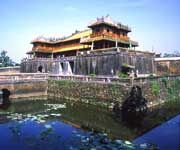Four citadels or defended enclosures made up the city: Kinh Thanh (Capital City), for official administrative buildings; Hoang Thanh (Imperial City) for royal palaces and shrines; Tu Cam Thanh (Forbidden Purple City) for the royal residences; Dai Noi (or Inner City); and Tran Binh Dai, an additional defensive work in the north-east corner of the Capital City, designed to control movement on the river. A fifth fortress, Tran Hai Thanh, was constructed a little later to protect the capital against assault from the sea.
Planning lasted from 1803 to 1805, and it was not until 1832 that construction was complete. The new capital was much larger than its predecessor, Dong Trang, and encompassed several villages as well. The fortress itself was modelled on the European style of Vauban, the first of its type in South-East Asia, but the complex suffered considerably as a result of military operations in 1885, 1947 and 1968.
The main enceinte, the Capital City, is square in plan, each side measuring 2,235 m. The defensive walls have six projecting bastions on each side and ten gates. The external defensive works comprise a berm, ditch, and glacis. The buildings inside the Capital City include various former ministerial buildings, the Royal College and the Hué Museum.
The Inner City is rectangular in plan and defended by brick walls, supplemented by a moat and wide berm; there is a single entrance on each of the walls. Inside it is divided by walls into a number of zones - the Great Ceremonies Zone, the Worshipping Zone, the residential zone of the King's Mother and Grandmother, the storage and workshop zone, the garden and school zone for royal princes, as well as the Forbidden Purple City. The palaces within the Inner City are similar in style and design, set on a raised podium, with wooden trusses (usually ironwood), gilded and painted pillars and rafters, brick walls, and roofs of yellow- or blue-glazed cylindrical tiles. Roof edges are straight, and the decoration, both internally and externally, is abundant. Among the most important buildings are the Palace of Supreme Harmony, the royal reception hall; the Mieu Temple, the royal place of worship; the Queen Mother's Palace; and the Pavilion of Dazzling Benevolence.
At the heart of the complex is the Forbidden Purple City, surrounded by brick walls. There is a single gate in the front wall, reserved for the use of the king, and the other walls have several entrances, each with a specific purpose. Originally there were over 40 buildings within the walls, but most are now in ruins and only their foundations survive.
Outside the Capital City there are several associated monuments of importance. These include the tombs of the Nguyen dynasty to the south of the Perfume River. Other structures along both banks of the river are buildings related to the spiritual life of the dynasty, including the Temple of Literature, the Esplanade of the Sacrifice to the Sun and Earth, the Royal Arena and the Temple of the Roaring Elephant, and the Celestial Lady Pagoda.
Browse All UNESCO World Heritage Sites in
Vietnam. The original UNESCO inscription
Here!!!




